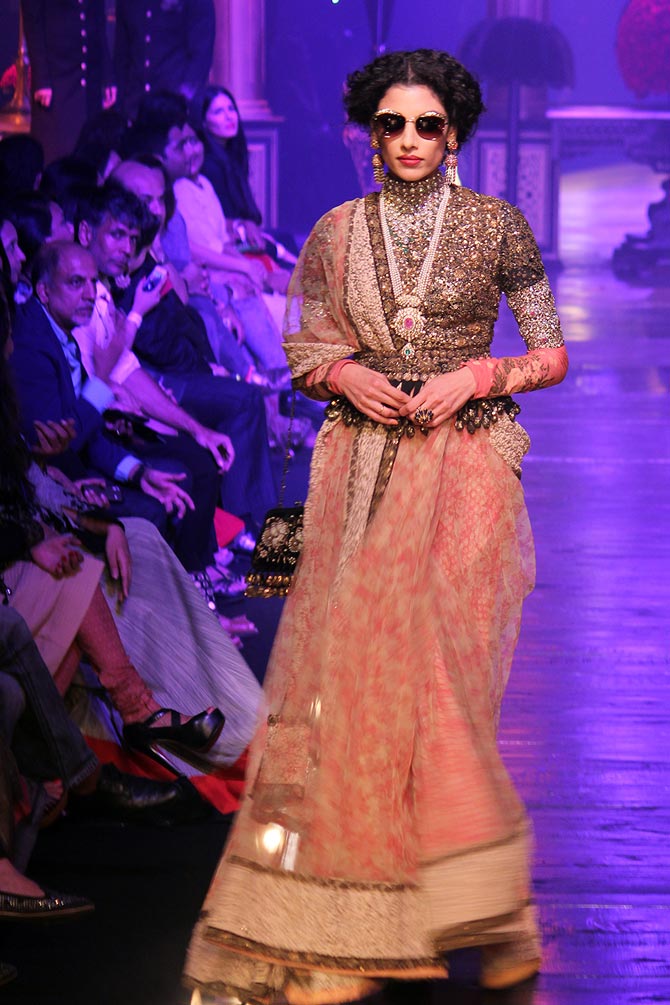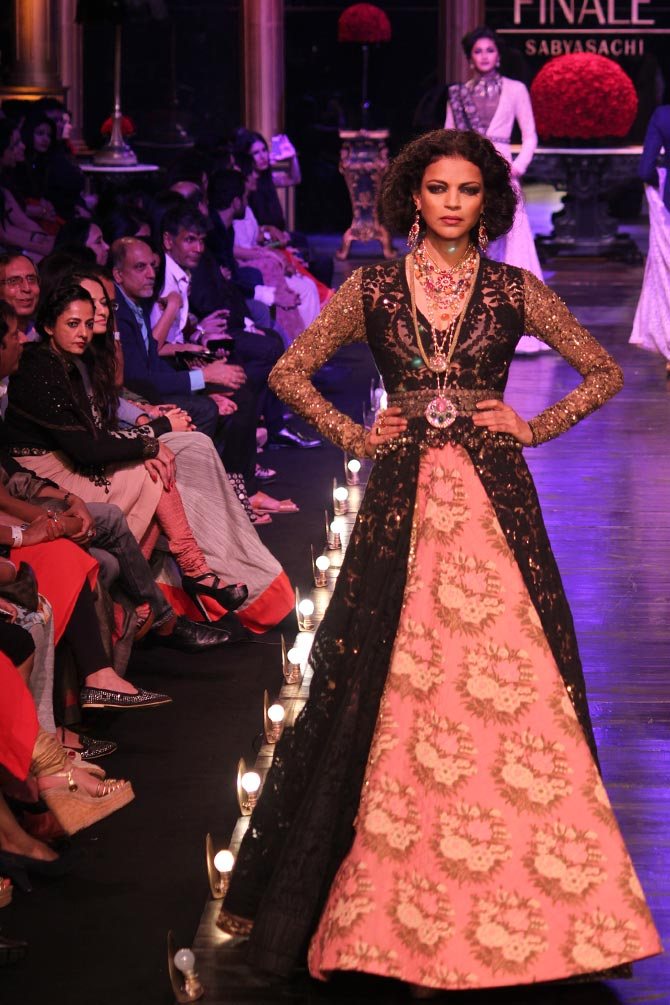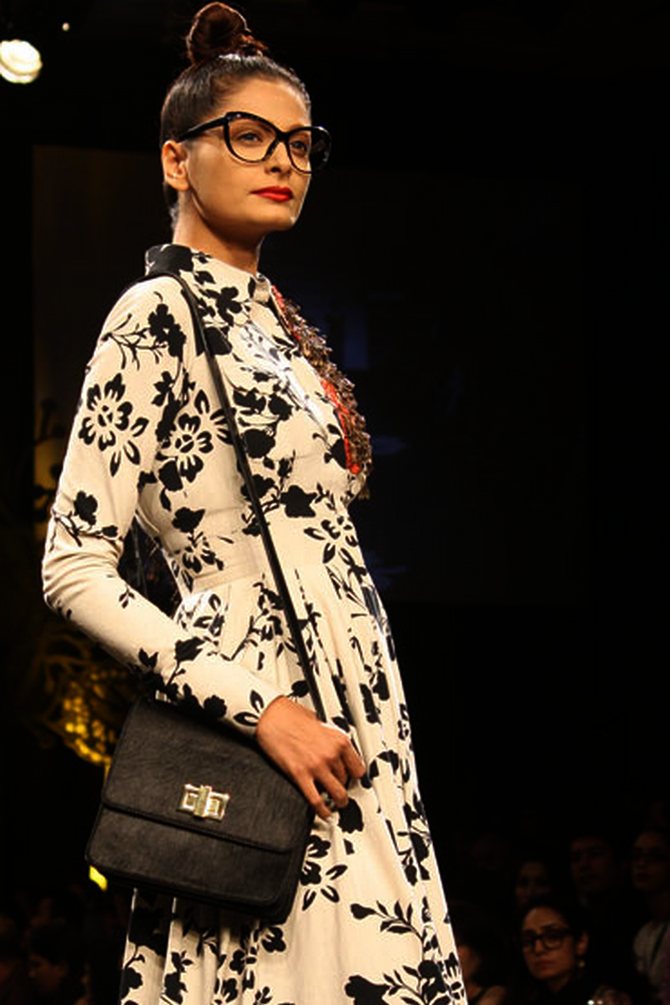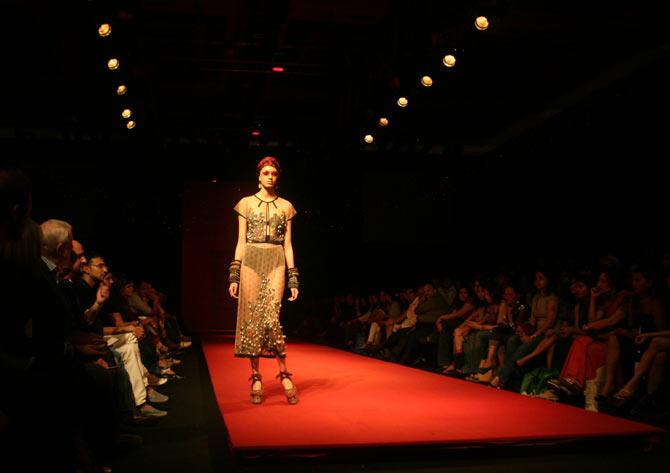
Nostalgia helps Sabyasachi Mukherjee, inarguably India's most talented fashion designer, stay relevant discovers Shaikh Ayaz who met him only just hours before he closed the Winter-Festive 2013 season of Lakme Fashion Week in Mumbai recently. (See photos from the show here)
It's the afternoon of the finale at Lakme Fashion Week in Mumbai and as one would expect, everybody who's anybody is running around fixing any lapses that comes in their range of sight. Except Sabyasachi Mukherjee who will unveil his new collection to a packed audience later that night.
The Kolkata-born designer, who prefers being called a revivalist, is a portrait of calm. But it could very well be an outer impression meant for visitors like us. Many things are going on inside his head. And inside his head throbs a very penetrating and sharp mind.
His lifelong subject has been that great Proustian bedrock -- memory. As he phrases it: "Nostalgia is my chicken soup." In between several phone calls, assistants barging in with VIP requests for his show's passes, last minute supervision and other sundry interruptions, Mukherjee talks about his inspirations, ideology and Brand India.
Your label was doing very well in New York. Why did you decide to wind up and focus instead on India?
India was going through this phase where everyone abroad was looking at coming back. What also happened at the downturn is that we noticed that Americans had a lot of Prada handbags and Gucci shoes but mortgaged houses, whereas in India we didn't have the brands but we had a house which we could call our own, money saved for our children's education and a little bit of gold.
I think this 'backward thinking' that people laughed at about India is what stood us in good stead during the bad times. When I was supplying to the West, I realised I was making clothes for people whom I did not have any connect with.
I didn't know who was wearing my clothes, whether I was making a difference in their lives.
When I came back to India I tried to touch lives through my market, through the copy markets, through films (Black, Guzaarish and English Vinglish among others) and through blogs that in many ways contributed to the revival of nationalism.
There is a Bengali poet called Michael Madhusudan Dutta who always wanted to write poetry in English till one day he went abroad. He was mocked and told, 'If you don't know how to write poetry in your mother tongue then you are a failed poet.' He came back and started learning Bengali and later wrote some very beautiful Bengali verses. That's what happened with me.

What is your creative process? How much in advance do you conceive your collections for LFW?
I have never been able to pinpoint that because you see, when you start something with the idea of starting it never really starts. Anybody who's creative will tell you that they can't put a timeline or a deadline to creativity.
Of course, there are things we do under stress which sometimes brings out the best in us and sometimes doesn't because you are still guided by commercial limitations and processes.
You know cows have this process of eating called chewing the cud which means they actually first masticate the grass, store it inside and then it bring it back again to chew it when they are hungry. My process is quite the same.
My mind is like this camcorder of memories, ideas and processes. At times, inspiration could hit inside the loo or on a flight. I don't ever pencil down anything.
Every new year for the last twenty years I have been making a resolution that I will get an organiser or a diary. (Smiles) It never happens. So if you ask me, 'Did you start thinking about LFW one week from now or ten weeks from now' I will tell you simply, 'I don't have an answer.' These are just memories and ideas that eventually come back.
They are triggered off by things, by a certain smell or by a colour I may have seen on a woman. I was at a Calvin Klein party in New York and I saw this woman who was wearing a white linen dress and had a big, deep cut-out back. A black leather bra was visible.
I was like, 'This must be a very aggressive and strong woman.' From that woman came the idea of the French Vogue ex-editor Carine Roitfeld.
Then I thought of the YSL girl. From the YSL girl I started thinking of the Gucci girls.
So the mind travels because of a trigger point and ultimately it leads to inspiration. So this latest collection came out of the back of that woman I saw at the Calvin Klein party.
Do you have a muse in mind when you design?
Actually for me, the very process of clothing starts with 'Who is my customer/Who am I designing for?'
I always have this fictitious muse in my head when I am designing. It could be a woman I have seen.
Let's say, she is 65 and sitting with her 73-year-old husband eating chocolate in the middle of an afternoon in a Parisian cafe.
She has a bright red lipstick. They both have grey hair and are wearing shabby clothes but you know that they have seen better days.
My mind will start romanticising the idea of this woman: who is she and where she comes from. It is only when I distil the idea of the woman that the design comes in.

When we see your collection, there is always a feeling that you are revisiting the past. Does it come consciously or unconsciously?
I am a memory person. I distil the most beautiful memory of my life and use it. I was born in 1974.
From 1974 to say, 1989-90, I had an idyllic life. I used to go to school by a hand-rowed boat.
We had a Rabindra Sangeet teacher who used to teach us music while we used to cross the ferry. We had a garden next to the river. As kids, one of our biggest pastimes was to fish.
Now, you don't meet a city guy who says, 'You know, on Sundays I go fishing.' Everybody has a comfort factor.
Nostalgia is my chicken soup. It makes me feel good. Nostalgia is also a great marketing tool. There is a reason why we need nostalgia in our lives because of the fact that we have such hurried lives.
People are rushing and running. They don't have time for relationships. The obvious fallout is that they don't have time to reflect. When you see a piece of clothing, an ideology or a piece of music that belongs to the bygone era you feel like you want to covet it.
Today, if we had a very idyllic life I don't think nostalgia would sell. It sells because of the maladies of the modern world.
It has become fashionable to say that the past was 'romantic.' Some decades from now, kids will say 2013 was the golden age. So past is by default always better than the present.
It could be true but life was certainly romantic, beautiful, cultural and more fulfilling in the past.
Today, everybody thinks better means bigger and faster. In 2004, I did a collection called The Snail. The idea was to slow down. I had written that slowing down does not mean dropping out. In my scheme of things it means choosing a better life.
That's when I started seriously toying with the idea of nostalgia because I realised that today if your neighbour has a car, you want a bigger car; if he has a house in Miami, you want one in Tokyo.
We are not doing things for ourselves. We are doing things to compete with others. At the end of the day who are we competing with? If we are stripped down to our bare basics people who we are competing with would mean nothing to us.
Everybody has this person in college they could not stand. And twenty years later when you see the same person with a paunch, receding hairline and a number of children in tow you actually feel sorry for him.
What happens is that when you step out of that zone of pettiness, you realise that the world has a much better things to give. Nostalgia allows you to get there. It allows you to escape.

That's why do we see a sense of repetition in your clothes?
Exactly. Repetition creates icon-ism and that's why I like my clothes to be repeated a little. I think identity, depth, believability, gravitas and stability of a person comes from maturity.
When people are young they try different hairstyles or makeup till they find a look and then they keep it stable for the rest of their lives. Why repetition is important is because it lends a certain visual credibility to a person's aura and the recollection of the person's visual self is also prominent in people's mind.
In my collection you will see evolvement but there will also be repetition. What evolvement does is that it takes you to a higher ground whereas repetition grounds you.
Anchorage and at the same time new flights of fancy often make a very potent DNA for any brand. It's very important to change but it's equally important to hold back.
How do you reconcile your ascetic beliefs with the vain world of fashion?
Fashion is in many, many ways a superficial business. (Smiles) I almost find myself reluctant to seduce fashion. Sometimes I do, but if I had my way I wouldn't.
People who pursue fashion have a singularly lonely life. When your handbag replaces your best friend you know that you have a problem. One of the reasons why the brand is successful is that I have never been a fashion insider.
I have always lived on the fringes. When I look at the front two rows of the fashion shows, I realise that most people have dysfunctional relationships. They are trying to create a facade by wearing super brands.
All you need to do is pat that person on the shoulder and say, 'I understand' and that person will break down. That's why I am nice to people. My anthem is what Richard Gere said in Pretty Woman, 'Stores are never nice to people. They are only nice to credit card.'

You spoke about Rabindra Sangeet. Were Rabindranath Tagore or Satyajit Ray a big influence on you?
Very big. I listen to Rabindra Sangeet every single day of my life. If you put me in a bathtub, that's what I hum. It makes me feel empowered. You have to be a Bengali to understand that.
No amount of translation will give you the real feel of his work. I really think Tagore is lost in translation. And what do I say about Ray?
To do the kind of cinema he did at the time and to have that kind of vision was amazing. There was also Ritwik Ghatak who was a greater artist than Ray.
But what Ray had was a perfect balance of art and commerce. He was a great businessman who knew how to market his films.
There are so many people who are far more talented than me. I don't think I make the best clothes in the country but I have the strongest package.
You faced a lot of criticism for Vidya Balan's Cannes wardrobe. What thoughts were running through your mind when you were reading all those post-Cannes bashings?
One of the reasons why I got bashed was not because of me or Vidya but because of the combination of what we both represented together.
Vidya is a woman who was always penalised and criticised for bad clothes and for having a body weight problem. But they don't understand one thing -- that her first day job is to act and not look good.
I was in London on a day when the Buckingham Palace is opened up and the royalty meets the commoners. Every single Englishwoman was wearing a hat. Some critic said that Vidya's covered head was an image of subjugation.
I think it was about benevolence, respect and a whole lot of other things. And also, in a way, it was pride. I have never understood how a short skirt can liberate you while covering your head can be subjugating.
There is this weird burn-your-bra, rebel without a cause syndrome going on right now. All these are issues created by women for women. In India, when it comes to fashion women tend to box women more than men do. They will say, 'She is an aunty.' I find that so sad.

India has witnessed a rise in sexual crimes against women in recent years. There is an ongoing debate that centres on whether the twin influences of fashion and Western culture are to be partly blamed for this. Do you think clothing -- short and revealing dresses -- have anything to do with rape?
I think it's just got to do with the distribution of wealth. Sometimes, I don't even think people are sexually depraved to do what they are doing. It's the classic story of Dr Jekyll and Mr Hyde where they become human beings that they themselves can't recognise. It's a failure of society at large. It can't be pinned down to something as obnoxiously frivolous as clothing.
At a time when the country is battling social issues including gender rights and women's safety, what is your position on India at 66?
The country is a shame right now. But the good thing is that if selfish politics has let the country down I also think that whenever there is anarchy a great voice of reason will rise and it's rising among the youth.
Whenever there is greed, unrest and indiscipline somewhere down the line a voice of idealism will surface. When there is too much of black you would want to wear white. When there is too much of ugliness people would want to automatically seek beauty and a path to better life. I hope India at 75 might be a better country than India at 66.